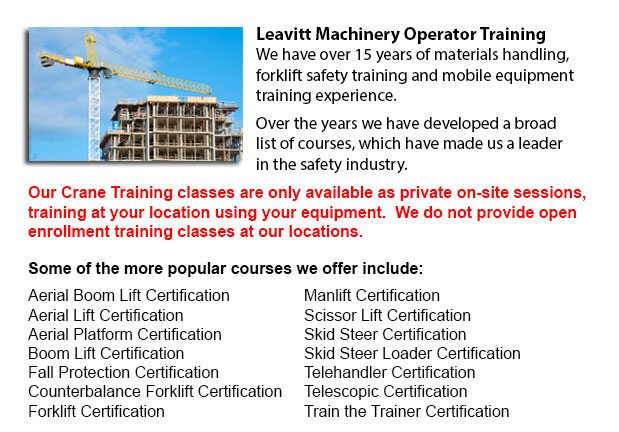
Langley Overhead Crane Safety Training - Overhead crane safety training equips operators with skills and knowledge about crane safety precautions, materials handling, accident avoidance, and equipment and stock protection. Trainees would learn the kinds of overhead cranes, their capabilities and their uses in various industry settings. For operators who are licensed and trained, the shift in liability moves to the operator from the company. Thus, the program emphasizes individual operator tasks.
The operators in the overhead safety training program will receive instruction on the correct techniques for performing inspections: the more detailed in-depth inspection and the pre-shift inspection. These are vital every day routines that should be logged. Correctly recorded pre-shift inspections help to protect the company from liability in the event of an accident. Pre-shift checks likewise prevent accidents, damage and expensive repairs. Operators learn how to designate a specific person to carry out checks, how to report problems, and how to maintain the log book.
Each and every inspection should be documented and carried out regularly. Things which must be inspected for possible concerns, consist of: increase in the throat opening, hooks for cracks, degree of twist; hoist ropes for corrosion, loss of diameter, worn wires, broken wires, bird caging and kinks, chemical and heat damage; chains for nicks and gouges, twists, corrosion and cracks, distortion, excessive wear, pits, stretching, damage from extreme heat.
Operators learn proper rigging methods in this program. Rigging involves understanding the manufacturer's data plate, determining the material weight to be lifted, selecting the gear, and using safe practices to secure the load. The program include in detail the following: safe working loads, and the capacities of chains, ropes, shackles, slings and hooks.
It is essential to understand who may use the cranes at your facility, the job's physical requirements, and operator credentials needed for specialized tasks and permits. Safety must be prioritized when using near pedestrian traffic.
The duties included in the safe crane utilization consists of undertaking visual inspections, checking for hydraulic leaks, testing the controls, checking the safety guards, examining the hook and hoist rope, braking mechanisms and limit switches. Correct reporting methods are important. These subject matters are all included in depth in the program.
The course also consists of the proper lifting and moving methods with hoists and cranes. Operators would likewise learn proper hand signals. Training involves how to raise the load, attach the load, unhook the slings, abort a lift and set the load.
The steps involved with moving the load, includes: stopping and starting procedures, controlling and guiding the load, working with signals and observing working conditions. In the event of power failures, the operator will have to know how to proceed. The course covers techniques for lowering the load and removing the slings, parking the crane, storage equipment, and securing an indoor and outdoor crane.
-
Operator Safety Certification | Re-Qualification Certification | In-House Instructor Certification in Langley
Lift trucks are utilized in nearly all warehouse operations and in boat yards and in industrial construction sites. The reach feature of a forklift is a vital component used in several applications like for example whenever a shelving system is being... More -
Skid Steer Loader Certification in Langley
The engine powered skid-steer loader consists of a small and rigid frame, equipped along with lift arms that could connect to numerous industrial attachments and tools to carry out several labor saving jobs. Normally, skid-steer loaders are four-whee... More -
Langley Forklift Training Classes
Langley Forklift Training Classes - Forklift are heavy pieces of industrial machines that are utilized in transporting and the handling of merchandise and materials. They are often known as Lift trucks and are found in all kinds of industries. Employ... More -
Langley Heavy Equipment Operator Certification
Langley Heavy Equipment Operator Certification - The heavy equipment operator is an individual who manipulates the controls and drives various kinds of big machinery. Heavy machines is most commonly used on construction sites in order to deliver supp... More -
Langley Crane License
Langley Crane License - Crane operators ought to be "credentialed", which means they ought to own a crane operator license or certification. Credentialing is considered a mandatory governmental prerequisite to be able to practice as a crane operator.... More -
Langley Forklift Training School
Langley Forklift Training School - Forklift Training School And What It Truly Has To Provide - Industry and federal regulators have established the criteria for forklift safety training according to their current standards and regulations. People wis... More -
Langley Boom Lift Certification
Langley Boom Lift Certification - Elevated work platforms allow maintenance operations and work to be performed at heights that can not be reached by whichever other way. Workers utilizing boom lifts and scissor lifts could learn how to safely operat... More -
Langley Manlift Safety Training
Langley Manlift Safety Training - Manlift operators need to be cognizant and aware of all the potential dangers which are connected with specific classes of scissor lifts. They have to be able to operate the scissor lift in a way that protects not on... More

Forklift Certification Langley
TOLL FREE: 1-888-254-6157
Langley, British Columbia
forkliftcertificationlangley.com
Email Us
About Us


